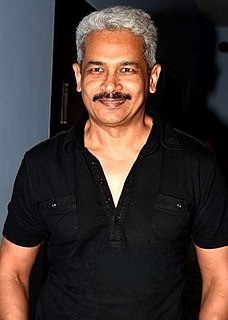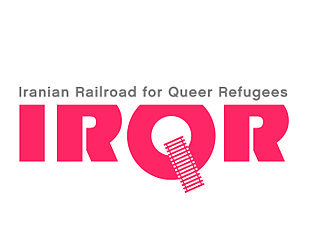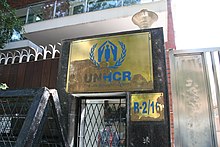
The United Nations High Commissioner for Refugees (UNHCR) is a UN agency mandated to aid and protect refugees, forcibly displaced communities, and stateless people, and to assist in their voluntary repatriation, local integration or resettlement to a third country. It is headquartered in Geneva, Switzerland, with over 17,300 staff working in 135 countries.

The Pacific Solution is the name given to the Government of Australia policy of transporting asylum seekers to detention centres on island nations in the Pacific Ocean, rather than allowing them to land on the Australian mainland. Initially implemented from 2001 to 2007, it had bipartisan support from the Coalition and Labor opposition at the time. The Pacific Solution consisted of three central strategies:

Afghan refugees are citizens of Afghanistan who were compelled to abandon their country as a result of major wars, persecution, torture or genocide. The 1978 Saur Revolution followed by the 1979 Soviet invasion marked the first wave of internal displacement and international migration from Afghanistan to neighboring Iran and Pakistan; smaller numbers also went to India or to the former Soviet Union. Between 1979 and 1992, more than 20% of Afghanistan's population fled the country as refugees. When the Soviet forces left Afghanistan in 1989, many began returning to their homeland. They again migrated to neighboring countries during and after the Afghan Civil War (1992–1996) but between 2002 and 2022 most have returned to Afghanistan.

Atul Kulkarni is an Indian actor, producer and screenwriter who works in Hindi, Marathi, Kannada, Malayalam, Tamil and Telugu language films. Kulkarni won the National Award for the Best Supporting Actor for the films Hey Ram and Chandni Bar. He is also the president of Quest, a research-action organization concentrating on enhancing quality of education. He left his study in engineering at College of Engineering, Pune while he was in his first year. He is known for his performances in films like Hey Ram, Chandni Bar, Rang De Basanti (2006), Natarang (2010) among others.

Since its independence in 1947, India has accepted various groups of refugees from neighbouring countries, including partition refugees from former British Indian territories that now constitute Pakistan and Bangladesh, Tibetan refugees that arrived in 1959, Chakma refugees from present day Bangladesh in early 1960s, other Bangladeshi refugees in in 1965 and 1971, Sri Lankan Tamil refugees from the 1980s and most recently Rohingya refugees from Myanmar. In 1992, India was seen to be hosting 400,000 refugees from eight countries.
Refugees in New Zealand have two main pathways for resettling in the country. Asylum seekers may seek protection after arrival in New Zealand. Refugees or protected persons may also be resettled from offshore through New Zealand's Refugee Quota Programme. Refugees who have been resettled can apply to sponsor relatives to join them. In 2017/18 a community sponsorship pathway was trialled, extended from 2021.

The Iraqi diaspora refers to native Iraqis who have left for other countries as emigrants or refugees, and is now one of the largest in modern times, being described by the UN as a "humanitarian crisis" caused by the 1991 Gulf War and 2003 invasion of Iraq and by the ensuing war.
There have been many waves of refugees and emigrants from Iraq since the late 1970s until the present. Major events the modern history of Iraq resulted in the flight of what are now millions of Iraqis: more than three decades of repression and occasional violent attacks and massacres against the Kurdish population in the north and the Shi'a in the south perpetrated by Saddam Hussein's regime, the Iran–Iraq War of 1980–1988, the 1991 Gulf War, the economic sanctions that lasted from 1991 until the toppling of Saddam Hussein, and the 2003 US-led invasion of Iraq.
Afghans in Pakistan are citizens of Afghanistan who are temporarily residing in Pakistan as refugees or asylum seekers. It can also include permanent residing Afghan people. Most were born and raised in Pakistan during the last four decades. They are under the care and protection of the United Nations High Commissioner for Refugees (UNHCR). Among them are members and supporters of the Taliban, including those such as the Special Immigrant Visa (SIV) applicants who are awaiting to be resettled in the United States. Many are financially supported by family members residing in North America, Europe, Oceania, and elsewhere.

The International Railroad for Queer Refugees, formerly known as the Iranian Railroad for Queer Refugees (IRQR), is an advocacy group for LGBT rights in Iran. It was founded and is headed by Executive Director Arsham Parsi. It was set up on behalf of Iranian LGBT persons seeking safe havens both within and outside of Iran. It is the first Iranian NGO in the world, working on behalf of Iranian LGBT people around the globe.

Afghan diaspora refers to the Afghan people that reside and work outside of Afghanistan. They include citizens of Afghanistan who have immigrated to other countries. The majority of the diaspora has been formed by Afghan refugees since the start of the Soviet–Afghan War in 1979; the largest numbers temporarily reside in Iran and Pakistan. As stateless refugees or asylum seekers, they are protected by the well-established non-refoulement principle and the U.N. Convention Against Torture. The ones having at least one American parent are further protected by United States laws.
Afghan Indians are Indian citizens and non-citizen residents born in, or with ancestors from, Afghanistan. As of early 2021, there are at least 15,806 Afghans temporarily residing in India under a special protection and care of the United Nations High Commissioner for Refugees (UNHCR). Apart from citizens and expatriates, there are a number of communities in India who trace their ancestry back to Pashtun forefathers of Pashtunistan.
Sudanese refugees are persons originating from the country of Sudan, but seeking refuge outside the borders of their native country. In recent history, Sudan has been the stage for prolonged conflicts and civil wars, as well as environmental changes, namely desertification. These forces have resulted not only in violence and famine but also the forced migration of large numbers of the Sudanese population, both inside and outside the country's borders. Given the expansive geographic territory of Sudan, and the regional and ethnic tensions and conflicts, much of the forced migration in Sudan has been internal. Yet, these populations are not immune to similar issues that typically accompany refugeedom, including economic hardship and providing themselves and their families with sustenance and basic needs. With the creation of a South Sudanese state, questions surrounding southern Sudanese IDPs may become questions of South Sudanese refugees.
Refugees of the Syrian Civil War are citizens and permanent residents of Syria who have fled the country over the course of the Syrian Civil War. The pre-war population of the Syrian Arab Republic was estimated at 22 million (2017), including permanent residents. Of that number, the United Nations (UN) identified 13.5 million (2016) as displaced persons, requiring humanitarian assistance. Of these, since the start of the Syrian Civil War in 2011 more than six million (2016) were internally displaced, and around five million (2016) had crossed into other countries, seeking asylum or placed in Syrian refugee camps worldwide. It is often described as one of the largest refugee crises in history.
The Hazara people are an ethnic group who are mostly from Afghanistan, primarily from the central regions of Afghanistan, known as Hazarajat, they established a large diaspora which consists of many communities in different countries around the world as part of the later Afghan diaspora. There are currently a million Hazara who live in the Balochistan province of Pakistan mostly in Quetta, many of whom have been settled in the country for generations and are now Pakistani citizens. A similarly large Hazara community is also present in Mashhad, Iran, as part of the Hazara and Afghan diaspora.

The 2015 European migrant crisis, also known internationally as the Syrian refugee crisis, was a period of significantly increased movement of refugees and migrants into Europe in 2015, when 1.3 million people came to the continent to request asylum, the most in a single year since World War II. Those requesting asylum in Europe in 2015 were mostly Syrians, but also included significant numbers of Afghans, Nigerians, Pakistanis, Iraqis and Eritreans, as well as economic migrants from the Balkans.
A Refugee crisis can refer to difficulties and dangerous situations in the reception of large groups of forcibly displaced persons. These could be either internally displaced, refugees, asylum seekers or any other huge groups of migrants.

Voluntary return or voluntary repatriation is usually the return of an illegal immigrant or over-stayer, a rejected asylum seeker, a refugee or displaced person, an unaccompanied minor, and sometimes a second-generation immigrant, who is unable or unwilling to remain in the host country and who volunteers to return to their country of origin, or that of their ancestors.
The Citizenship (Amendment) Act, 2019 was passed by the Parliament of India on 11 December 2019. It amended the Citizenship Act, 1955 by providing a pathway to Indian citizenship for persecuted religious minorities from Afghanistan, Bangladesh and Pakistan who are Hindus, Sikhs, Buddhists, Jains, Parsis or Christians, and arrived in India before the end of December 2014. The law does not grant such eligibility to Muslims from these Muslim-majority countries. The act was the first time that religion had been overtly used as a criterion for citizenship under Indian law and attracted global criticism.
Migration and Asylum Project (M.A.P.), formerly known as the Ara Legal Initiative, is a refugee legal aid centre based in New Delhi, India. It provides legal aid and counselling to asylum seekers and refugees in India.











